Class 6 Science Chapter 12 Electricity and Circuits Extra Questions
CBSE Class 6 Science Chapter 12 Electricity and Circuits Extra Questions and Answers is available here. Students can learn and download the PDF of these questions for free. These extra questions and answers are prepared by our expert teachers as per the latest NCERT textbook and guidelines. Learning these extra questions will help you to score excellent marks in the final exams.
Electricity and Circuits Class 6 Science Extra Questions and Answers
Very Short Answer Questions
1. What is the direction of flow of current in a dry cell?
Answer: The current flows in closed circuit from +ve to -ve terminal of cell.
2. Name the +ve terminal of dry cell.
Answer: Carbon rod with a metal cap on it.
3. Name the -ve terminal of a dry cell.
Answer: Zinc metal plate.
4. What is dry cell?
Answer: It is a device which converts chemical energy into electrical energy.
5. What is solar cell?
Answer: A device which converts solar energy into electrical energy.
6. What is open circuit?
Answer: An electric circuit in which electrical contact at any point is broken is called open circuit.
7. Write one use of insulators.
Answer: Insulators are used in making switchboard, handles of testers, screw drivers.
8. What is the name of thin wire in the electric bulb?
Answer: Filament.
9. In which of the following circuits A, B and C given below, the cell will be used up very rapidly?

Answer: I circuit A the cell will get used up rapidly.
10. Figure given below shows a bulb with its different parts marked as 1, 2, 3, 4 and 5. Which of them label the terminals of the bulb?
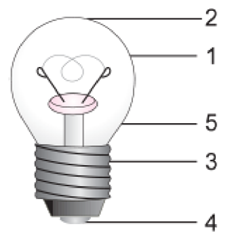
Answer: Labels 3 and 4 mark the terminals of the bulb.
11. What is inside the glass case of a bulb?
Answer: Filament
12. Why does an electric bulb not glow when both the wires are connected to the same terminal of a cell?
Answer: The current flows from one terminal to the other. When both wires are connected to same terminal, current will not flow.
13. Give one difference between a cell and a battery.
Answer: A cell produces electricity by chemical reactions taking place in it whereas battery is made up of two or more cells joined together.
14. Write any two uses of electric cells.
Answer: It is used in alarm clocks and wrist watches
Short Answer Type Questions
1. You are provided with a bulb, a cell, a switch and some connecting wires. Draw a diagram to show the connections between them to make the bulb glow.
Answer:
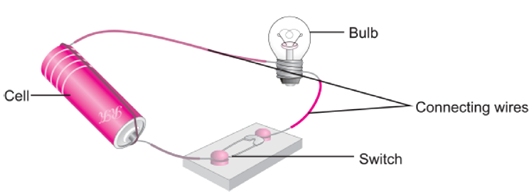
2. Will the bulb glow in the circuit shown below? Explain.
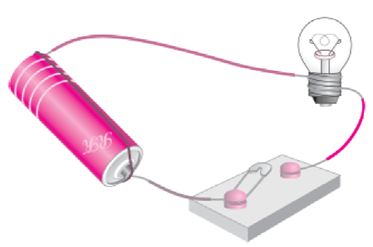
Answer: No. The bulb will not glow in this circuit because the switch is open and the circuit is incomplete. Due to this there will be no current flow.
3. An electric bulb is connected to a cell through a switch as shown in figure below. When the switch is brought in ‘ON’ position, the bulb does not glow. What could be the possible reason/s for it? Mention any two of them.
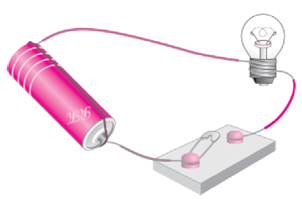
Answer: The reasons could be
- the bulb is fused.
- the cell is a used one.
- break in connecting wire.
- loose connections. (Any two)
4. A torch requires 3 cells. Show the arrangement of the cells, with a diagram, inside the torch so that the bulb glows.
Answer:

5. When the chemicals in the electric cell are used up, the electric cell stops producing electricity. The electric cell is then replaced with a new one. In case of rechargeable batteries (such as the type used in mobile phones, camera and inverters), they are used again and again. How?
Answer: Rechargeable batteries can be recharged by providing them appropriate current.
6. Paheli connected two bulbs to a cell as shown in the figure given below.
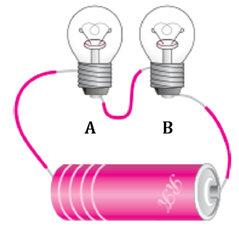
She found that filament of bulb B is broken. Will the bulb A glow in this circuit? Give reason.
Answer: No, bulb A will not glow as the circuit is not complete.
7. Why do bulbs have two terminals?
Answer: Bulbs have two terminals to connect the filament with the circuit so that the current can pass through it and get accumulated.
8. Which of the following arrangements A, B, C and D given below should not be set up? Explain, why.

Answer: Arrangement A is not desirable and should not be set up. This will exhaust the cell very quickly.
9. A fused bulb does not glow. Why?
Answer: In a fused bulb the filament is broken and the circuit is incomplete. The current will not flow and the bulb will not glow.
10. Paheli wanted to glow a torch bulb using a cell. She could not get connecting wires, instead, she got two strips of aluminium foil. Will she succeed? Explain, how.
Answer: Yes. Aluminium foils can act as connecting wires as it is a good conductor of electricity.
11. What are the essential components of an electric circuit?
Answer: Connecting wires, bulb, switch and cell are the essential components of an electric circuit.
12. Why should you not touch electric appliances and switches with wet hands?
Answer: Water is a good conductor of electricity and current passes very quickly through wet hands. Therefore, it can give us an electric shock.
13. Write two precautions that you must follow while handling electricity.
Answer:
- Wear rubber gloves or slippers.
- Never touch switches with wet hands.
14. When a bulb is fused, it does not light up. Explain why?
Answer: When a bulb is fused its filament breaks, which in turn breaks the electric circuit. Thus, current does not pass through it.
15. Why does a cell stop producing electricity after sometime?
Answer: When the chemicals in the electric cell are used up, the electric cell stops producing electricity. Since all the chemicals are used, no chemical reaction takes place which will produce energy.
16. Write any two uses of electricity?
Answer: Two uses of electricity are:
- To operate pumps that left water from wells or from ground level to the roof top tank.
- Electricity makes it possible to light our homes, that makes our tasks easier.
17: What will happen if we join two terminals of electric cell directly through a wire?
Answer: If we join two terminals of electric cell directly through a wire, the chemical in an electric cell get used up very fast and the cell will stop working.
18: What is an electric circuit?
Answer: Arrangement that provides a complete path for electricity to pass (current to flow) is known as electric circuit.
19: Explain how the bulb glows in circuit when it is connected to an electric cell?
Answer: When the terminals of the bulb are connected with that of electric cell by wires, a current pass through the filament of the bulb and it makes the bulb glow.
20: How can an electric bulb get fused?
Answer: An electric bulb may get fused due to break in its filament. A break in the filament of bulb means break in the path of current between the terminals of electric cell.
21: Why rubbers and plastic used to cover electric wires and plug tops?
Answer: Rubbers and plastic are used to cover electric wires and plug tops because they are insulators and do not allow electric current to pass when we touch plugs and switches.
22: Why is distilled water used in the batteries and not the tap water?
Answer: Because distilled water acts as an insulator as it is purest water. Whereas tap water has salts and impurities and acts as a conductor.
23: Why is handle of tools like screw driver, pliers are covered with plastic or rubber?
Answer: Because they are insulators and avoid direct contact with electric current while touching electric wires.
24: Generally what can be components of an electric circuit?
Answer: Components of electric circuit can be following:
a. A cell or a battery
b. Connecting wires made of copper or aluminium
c. Switch
d. Bulb or other electric device
25: What is the function of an electric switch?
Answer: It is a simple device that either breaks the circuit or completes it. For example-in a microwave or toy cars we have switches to turn it ON or OFF.
26: What is an electric cell? How many terminals it has?
Answer: An electric cell is a device that converts chemical energy into electrical energy. It has two metal plates indicating two terminals-negative and positive. It has chemical inside it.
27: Statement is true or false:
a. Bulb has one terminal.
b. Electrolyte is present in the cell.
c. Copper is good conductor of electricity.
d. Circuit shows the path of current.
Answer:
a. False
b. True
c. True
d. True.
28: Classify the following as conductor or insulator:
Eraser, coin, glass, pencil, needle, key, iron nail, plastic scale
Answer: Conductor-coin, needle, key, iron nail
Insulator-eraser, glass, pencil, plastic scale
29. Mention two advantages of a dry cell.
Answer:
1. It converts chemical energy into electrical energy.
2. It is light and small in size.
30. Draw the circuit diagram for operating a bulb with the help of a dry cell.
Answer:
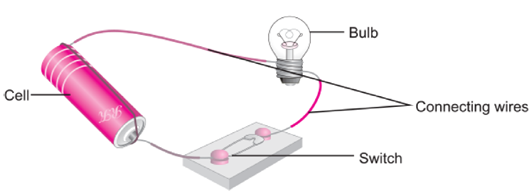
31. Define conductors and insulators. Give one example of each.
Answer: A conductor is that which easily allows the passage of current through it. Example: Aluminium or any metal.
An insulator is that which does not allow the passage of current through it. Example: Rubber.
32. Identify conductors and insulators from the following: Eraser, paper, matchstick, copper wire, pencil lead, polythene
Answer: Conductors: Copper wire, pencil lead.
Insulator. Eraser, paper, matchstick, polythene.
33. Name the scientist who invented electric cell and the scientist who invented electric bulb.
Answer: Electric cell: Alessandro Volta.
Electric bulb: Thomas Alva Edison.
34. Give one activity to prove that air is an insulator.
Answer: Take an electric circuit, keep the terminals unconnected in the air. The bulb will do not glow, as air is an insulator and does not allow the current to flow through it.
35. In any electric circuit, when the switch is on and the current flows through it why do the wire, switches, bulb or devices become hot?
Answer: This is because electric energy changes into heat energy.
36.The headlights of a car have reflectors behind the bulb. What is the function of reflectors?
Answer: The reflector helps in reflecting the light into a focussed area.
Long Answer Type Questions
1: (a)What is electric circuit?
(b) How many types of electric circuit are there? Define them.
(c)Draw a diagram to show the closed circuit for switch, bulb and dry cell.
Answer: (a) An electrical circuit is a path or line through which an electrical current flows.
(b)There are two types of electric circuit:
- Open electric circuit
- Closed electric circuit
Open electric circuit: The circuit in which electrical contact at any point is broken is called open electric circuit.
Closed electric circuit: The circuit in which electric current flows from one terminal of a cell or battery to the other is called a closed circuit.
(c)
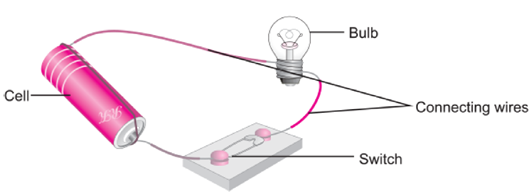
2. How can you explain that the human body is a good conductor of electricity?
Answer: If we stand barefoot on the ground and touch an electric wire, we will get an electric shock. This is because human body is a good conductor of electricity. Without slippers, current can easily pass through.
3. Why should we take care while handling electricity?
Answer: Carelessness in handling electricity and electric devices can cause servers injuries and sometimes even death, so we should take proper care while handling electricity.
4: What is the difference between conductor and an insulator? Explain with examples.
Answer: Materials that allow electric current to pass through them are called conductors. For example iron, copper etc. Metals are good conductors. Materials that do not allow electric current to pass through them are called insulators. For example- rubber, plastic etc
5. If you touch an electric wire carrying current you get a shock, but if on the same wire the birds sit they do not get any shock/current. Explain why?
Answer: When we hold the wire carrying current then the circuit is closed and the current flows from our body and enters earth but the birds sitting on the same wire do not get any current as the circuit is not complete. If the bird touches the earth wire, it will also die due to electric shock.
6. Boojho has a cell and a single piece of connecting wire. Without cutting the wire in two, will he be able to make the bulb glow? Explain with the help of a circuit diagram.

Answer: Yes, using the arrangement given below he can succeed in getting the bulb glow.
7. Figures A and B, show a bulb connected to a cell in two different ways.
What will be the direction of the current through the bulb in both the cases. (Q to P or P to Q)
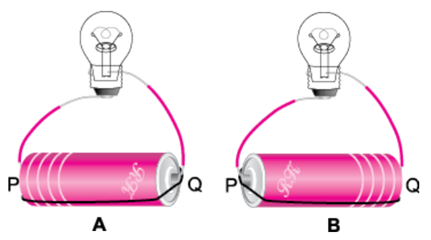
Answer: In Fig. (A) Q to P and in Fig. (B) P to Q.
8. A torch is not functioning, though contact points in the torch are in working condition.
What can be the possible reasons for this? Mention any three.
Answer: The possible reasons could be
- the bulb may be fused.
- the cells may have been used up.
- the cells are not placed in the correct order.
- the switch is faulty. (Any three)
9. Distinguish between the following.
(i) Insulator and Conductor
Answer:
| Insulator | Conductor |
| Materials which do not allow electric current to pass through them. | Materials which allow electric current to pass through them. |
| For example, plastic, rubber, etc. | For example, glass, air, etc. |
(ii) Open circuit and Closed circuit
Answer:
| Open circuit | Closed circuit |
| Circuit having a gap in its path. | Circuit which forms a complete path. |
| The bulb does not light up in this circuit. | The bulb lights up in this circuit. |
(iii) Open switch and Closed switch
Answer:
| Open switch | Closed switch |
| When the switch breaks the circuit, it is called open switch. | When the switch completes the circuit, it is called closed switch. |
| Current does not flow in an open switch. | Current flows in a closed switch. |